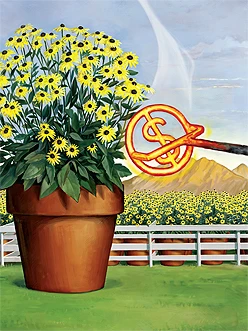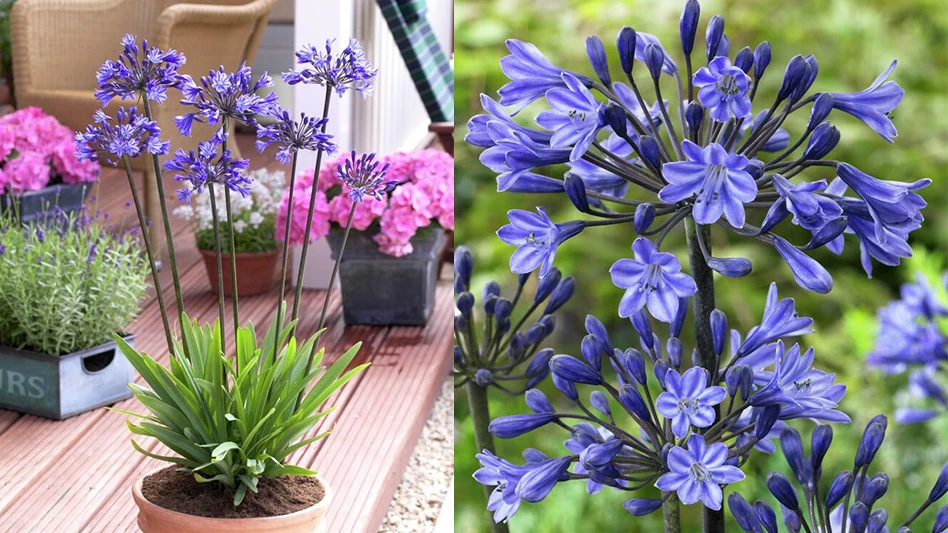
 There’s nothing more American than branding. The good old USA is the birthplace of thousands of iconic name brands. Branding is a part of our culture. It influences our buying decisions, our pop culture—even our art.
There’s nothing more American than branding. The good old USA is the birthplace of thousands of iconic name brands. Branding is a part of our culture. It influences our buying decisions, our pop culture—even our art.
But branding doesn’t permeate every realm. Our very own green industry offers evidence of that. The concept of branding plants began to seriously take hold less than two decades ago. Over the years, companies have poured enormous amounts of time, money and resources in the quest to create a “household name” for ornamental plants. Meanwhile, garden centers have had the (perhaps unenviable) task of vetting the dozens of branded offerings that came down the pike each year.
Building a brand. Growers and breeders built brands for the same reasons cited by other consumer product manufacturers: to increase perceived value, improve visibility, provide differentiation and, of course, make more money. Ideally, these benefits trickle down to retailers.
Frances Hopkins had these considerations in mind when she began building her Stepables brand. The marketing behind this line of foot-traffic-tolerant plants has earned Hopkins awards from major floriculture organizations.
“At the time I started Stepables, I had been selling groundcovers for 10 years and saw a trend emerging for plants that could be used in between stepping stones,” she said. “I never had any intention of going national. All I wanted to do was create a great niche for my local market. So, I definitely accomplished that and a whole lot more.”
.jpg)
The brand concept took off not solely because it was clever, but because the product name offered customers a solution to a problem. The brand name made selecting these plants a lot easier.
“Brands enable the customer to cut through the decision-making hassle and go to choosing directly what they recognize and need,” Hopkins said.
“This mental Post-It-Note should be engraved with—if a brand has done its homework right—a certain perceived value, recognizable brand message and product differentiation.”
Anthony Tesselaar, the man behind Flower Carpet roses and other international plant brands, sees branding as a downright necessity these days. Generation X and Y, especially, are trained to shop in this fashion. Brands guide where their dollars go.
“The people in our industry are older and love plants,” Tesselaar said. “And they think that everyone loves plants. The customers, though, they are bred for brands. They’re driven by both quality and brands.”
For garden retailers that are struggling with brands, Tesselaar said it helps to think of the concept outside of the nursery. In a supermarket or department store, consumers are bombarded with hundreds of brands at all different price points.
“When customers go into a shop with a mixture of brands and no-name stuff, they think ‘Here I can get a choice of everything. I can choose from high, medium or low, and it’s my choice.”
Retail reality. Plant companies are counting on presentation to help branded items rise above the fray. Jeff Griff with Lowe’s Greenhouses in Chagrin Falls, Ohio, has concluded that well-labeled, nicely packaged plants sell better than “undressed” items.
“I still find that a huge picture-tag for items not yet in bloom helps sell plants—especially perennials—early in the season, but the plants must have good value compared to the remainder of undressed plants available,” Griff said. “Is this 20-percent more? 30-percent more? It depends on the plant type, time of year and branding components.”
Packaging and point-of-purchase materials tell customers “this is something different.” But Griff questions whether consumers truly get what “different” entails.
“There is still no recognition of big brand names,” he said. “Customers don’t understand the whats and whys of these brands. They do understand clean, bright packaging, planting instructions and color, color, color!”
Other garden centers have found that the store’s own reputation—and brand, if you will—carry more weight with customers than what’s on product packaging.
“As a retail manager I have seen, carried and even grown many brands over the years,” said Noah Schwartz, grower and manager of greenhouses with Matterhorn Nursery, Spring Valley, N.Y. “I believe that a majority of our customers come to our nursery not for any particular national or local brand; but they shop with confidence because we have chosen the right plant/variety for them.”
.jpg)
Schwartz said this doesn’t mean people haven’t come in asking for a particular brand name. But they’ve never stormed out unhappy because they don’t have the product in stock.
“Our customers are loyal to Matterhorn, not to Proven Winners or Wave.”
Skip Shorb, owner of American Plant with three retail locations in the metro D.C. area, echoes these sentiments. His stores have sold branded annuals for a number of years. But he hasn’t seen a great deal of consumer demand for brands, especially if a non-branded plant in close proximity looks better on the shelf. Recently he’s had better luck with the Garden Elements plant brand available through the Master Nursery Garden Centers’ co-op.
“We do all the very professional POP for the line, but we’re firmly convinced it has done as well as it has because we suggest that this is ‘our company’s’ superior product. We strongly believe that the brand that brings folks into our stores is our name and reputation.”
Brand appeal
For every retailer that questions the relevance of national branding, there are others that have seen extraordinary success with brand names. Dan Truesdale with Rolling Green Nursery in Greenland, N.H., said the store’s new Creation Station, which prominently features Proven Winners plants, has been a big hit with customers. In this dedicated area customers find everything they need to create container gardens: decorative pots, potting soil and a selection of good-looking premium-branded plants.
Brand makers like Proven Winners have devoted money to research showing that this kind of cohesive brand presentation resonates with customers. The company recently completed a case study with the independent research firm StandPoint Marketing in which Proven Winners branded plants outsold generic offerings nearly 5 to 1.
The case study was conducted over a nine-day period (June 6-14) within two garden centers during non-peak dates, and centered on the performance of two display benches. Bench 1 featured only Proven Winners products in branded pots. The display also had bench tape, the company’s Colorwise tag sign, a “Plants for Sun” sign and flip book.
Bench 2 was a 50/50 mix: half Proven Winners branded plants; half unbranded products in green pots. The second bench was split to gauge the impact of POP materials on the first bench’s sell-through.
The results? PW plants from Bench 1 (with all the bells and whistles) outsold unbranded plants from Bench 2 at a rate of nearly 5 to 1. Branded plants from Bench 2 outsold unbranded plants from Bench 2 at a rate of less than 2 to 1. From the data, researchers concluded that branding materials resulted in higher sell-through rates.
“By not selling branded product, they [garden centers] are missing a huge opportunity for additional sales,” said Danielle Ernest, PR and brand development coordinator for Proven Winners. “That isn’t just coming from me because I work for Proven Winners, but because studies show it to be true, and I know personally how I buy as a woman—based on brand.”
.jpg)
Ernest puts it this way: As a consumer, if she sees an Ann Taylor-branded sweater that looks good on her, she can justify spending $100. Price isn’t the reason the majority of women make purchases, it’s more about impulse.
“I guess, as a consumer, if I walked into Macy’s and they didn’t carry Ralph Lauren or Liz Claiborne, I would wonder why,” Ernest said. “Or if Best Buy didn’t carry iPods or iPhones, I would think there was a problem. If a product is heavily advertised and marketed to consumers, why wouldn’t they [Macy’s or Best Buy] carry it?”
Bridging the gap
Good question. What’s it going to take to bridge the gap between the expectations of brand makers and the realities of retailers?
“I think the horticulture industry desperately needs more brands—but I mean good, complete branding programs that are meaningful to consumers, not just label designs that are supplier-centric rather than consumer-centric,” said Miriam Young, a publicist who works closely with several international horticulture companies.
“With a handful of notable exceptions, I feel there is a huge disconnect between the horticulture industry and the mainstream consumer, with both plant suppliers and retailers so focused on pushing their own name that they don’t stop to consider what it all means to the end user.”
Current plant-branding efforts create a catch-22 situation, according to Young.
“On one hand, suppliers who try to develop well-thought-through brands meet with resistance from distributors and retailers who fail to appreciate the added value, can’t be bothered with the extra work the point-of-sale [material] brings and seem paranoid about competition to their own label. On the other, retailers who do appreciate the value of good brands aren’t being offered them because of the low levels of take-up.”
 Skip Shorb at American Plant thinks what’s missing from the equation is an element of trust. A co-op branding model seems appealing, where everyone is an equal partner and the program is open to all independent garden centers. Then you’d have something all the players could believe in.
Skip Shorb at American Plant thinks what’s missing from the equation is an element of trust. A co-op branding model seems appealing, where everyone is an equal partner and the program is open to all independent garden centers. Then you’d have something all the players could believe in.
“I’m not sure how you’d create something like that,” Shorb said. “It has to be a strong commitment that’s real and believable.”
| Store branding matters How can garden retailers effectively maintain a store brand-image? Listen to a conversation on this topic with industry consultant Sid Raisch. CLICK HERE |

Explore the September 2009 Issue
Check out more from this issue and find your next story to read.
Latest from Garden Center
- Meet the All-America Selections AAS winners for 2025
- AmericanHort accepting applications for HortScholars program at Cultivate'25
- 2025 Farwest Show booth applications now open
- The Garden Center Group hosting 'The Financial Basics of Garden Retailing Workshop Series'
- Weekend Reading 11/22/24
- Hurricane Helene: Florida agricultural production losses top $40M, UF economists estimate
- Terra Nova Nurseries shares companion plants for popular 2025 Colors of the Year
- Applications open for Horticultural Research Institute Leadership Academy Class of 2026





